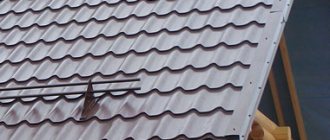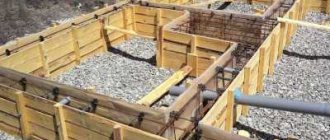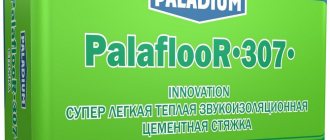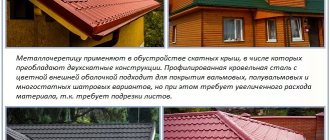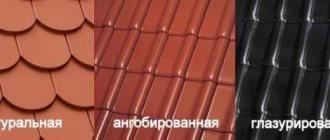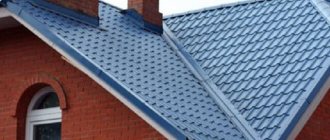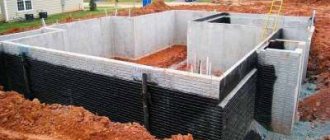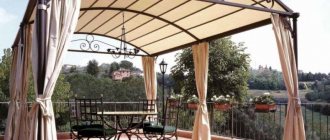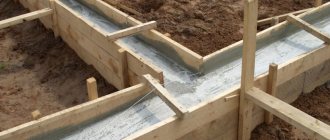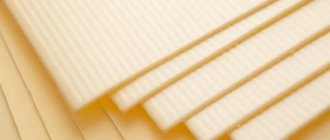0
744
Category: Private houses
Metal tiles are a type of roofing material that is shaped like profiled steel sheets. The surface of each product is covered with a polymer coating. It protects metal products from the effects of external climatic factors.
In addition, polymers protect against corrosion and thinning of the iron base. This type of roofing is used to create a roof with a slope angle of more than 15 degrees.
The main advantage of this type of finishing material is its ability to withstand temperature changes.
As for the negative qualities, metal tiles are not able to absorb loud sounds. Proper installation work helps increase sound insulation.
How to cover a roof with metal tiles? What should you consider when selecting consumables? You will find answers to these questions in our detailed material.
Advantages
The main advantages that determine the choice of this material, for example, Monterrey metal tiles:
Price. Currently, it is the most budget option among roofing materials produced by modern industry.
Installation. Here this material also occupies a leading position, since the implementation of these works cannot be stopped even by negative air temperatures.
Durability. The service life is from 40 to 50 years, another fact in favor of this roofing material, although it is inferior to real tiles, which can last up to 70 years.
Roof color. There are no restrictions here at all. After all, the manufacturing technology involves coating a sheet of steel with paint of any color.
In addition, it is a durable and fire-resistant material, environmentally friendly and easy to repair. Withstands temperatures over a wide range.
Important! Additionally, you can save by simplifying the rafter system.
How to install metal tiles on a hip roof
The installation process can only begin after the rafter frame has been completely lathed, a vapor barrier has been laid, and the mounting strip has been sewn.
Layout and trimming
Installation of metal tiles on a hipped roof begins with laying out and cutting sheets along the edge of the intersection of the slopes. Some of the sheets are lifted onto the roof and laid on a small hip slope, along the “break” line of the roof. To simplify the work, a marking cord is pulled from the ridge to the eaves; it must pass exactly along the axial hip rafter beam. This will help you align the edge correctly during the fitting process.
Starting from the bottom row, the sheets are sequentially laid on the edge of the hip and the cutting line is marked along the cord. The result is a line of steps made of metal tiles. Without disassembling the stepped row, the material is cut out and laid out in a similar way on the adjacent side of the hip slope. There should be a gap 3-4 mm wide between the edges; upon completion of the work, it will be closed with an additional overlay.
Fastening on the sheathing
After all four ribs of the hip roof have been laid out, it is necessary to align the edges of the lower sheets so that they are located at the same horizontal level. To do this, you can use cord markings or a more modern laser level.
Upon completion of cutting metal tiles on a hip roof, the sheets are marked, signed and sent for touch-up of the cutting line. Next, install the cornice strip and drip line. The rest of the hip roof is laid in the same way as in the case of a gable roof. After the bottom row of metal tiles is filled, it is immediately sewn to the frame with self-tapping screws. This is done in order to avoid accidental movement of the material, for example, during adjustment or due to strong wind.
Flaws
For an objective assessment, it is worth mentioning the disadvantages of this material:
- High thermal conductivity, requires additional insulation, as it does not retain heat well.
- Low sound insulation; if installed incorrectly, rain, hail and strong winds will reverberate through the house itself.
- Corrosion, rust forms at the cut points, so they need to be treated.
- Sealant for self-tapping screws; the quality of the roof depends on its quality, since over time in the sun they dry out and collapse, and in these places the roof may begin to leak.
Artificial stone countertops- Combisystem Gardena
Which staircase to choose for a private house to the second floor: types and varieties of material
Photos of houses with matte metal tiles (select photos)
You also need to remember about the ability of a glossless roof to maintain its plane. No matter how much the rafters or roof sheathing sag, matte metal tiles retain their ideal appearance.
Matte coating is ideal for complex roofs with a large number of slopes and lines of intersection of the coating.
In such structures, an effect often occurs when dust and contaminants washed away by rain from the upper tiers of roofing structures settle in paths on the lower sections of the roof slope.
For smooth tiles, streaks and marks are a real problem; on matte roofs this effect practically does not occur.
How to calculate the required volume
In order to correctly calculate the required volume of material, the roof area should be divided into rectangles (the size of the metal tiles is taken into account).
Then the calculation of a rectangular roof will look like this:
- it is necessary to measure the length of all roof slopes and the roof ridge;
- add overhang length;
- calculate the number of rows by dividing the width of the slope by the width of the sheet (rounded in ascending order);
- When calculating, it is necessary to take into account the width of the vertical overlaps.
Note! If there is no symmetry, calculate each slope separately and add it to the overall result.
When making calculations for metal tiles manually, it will be convenient to use graph paper for compliance. Keep in mind that the total area of the material exceeds the total area of the slopes by 20%.
Advantages and disadvantages of a hip roof under metal tiles
The use of a metal roof has always been a very reasonable option; galvanized metal practically does not rot and is not afraid of mechanical stress. Covering a hip roof with metal tiles makes it possible to take advantage of the advantages of metal and a sloping triangular frame.
The four-slope design has pronounced advantages:
- High resistance of the frame to strong storm squalls and snowfalls. If a complex system of inclined slopes is chosen, then the building does not need to be oriented on the ground relative to the wind rose;
- A hipped roof made of metal tiles, photo, looks much more elegant and attractive than standard gable and even more so single-pitch schemes.
For your information!
Today in the world there are at least two dozen different versions of hipped roofs, from the simple Danish hip roof to the roof of a Chinese pagoda with curved slopes. All of them are considered classics of modern architecture and are often copied in individual housing construction.
Disadvantages of a hipped design
The beauty of your home will require certain expenses and quite serious physical effort. Therefore, before choosing a hip scheme, it would be right to find out about the most important disadvantages of a tandem metal tile and a hip frame:
- The complexity of assembling and adjusting individual parts of a metal roof with a hipped roof. In order to assemble and install the covering, you will need a good eye and deep knowledge of the geometry of the rafter frame;
- Significant costs when cutting metal tiles for a hip roof. Due to the fact that the roofing sheets are rectangular in shape, they have to be cut according to the angle of inclination of the triangular hip roof.
Important! Due to the fact that the surface of the roofing sheet is profiled, it will be necessary to select the correct angle of inclination so that slanting rain does not penetrate under the ridge trim.
It is possible to install metal tiles on the roof of a hip roof without any residue only if the angle of inclination of the slope exceeds 55-60o. The design turns out to be very high, with broken slopes. But even in this case, it is necessary to trim the edges to provide a gap between the edges of adjacent sheets of coating.
Right choice
Before purchasing, you should find out how to cover a roof with metal tiles, and also decide on the parameters of the sheet thickness (0.45-0.5 mm); a thinner sheet is suitable only for temporary buildings.
Check to see if there is a primer underneath the paint (you can see it if you peel off some of the paint).
The paint should not warp or peel. Packaging of sheets must be neat, the sheets in them must be laid evenly. It is necessary to purchase only from trusted manufacturers.
Subtleties of choice
It’s not for nothing that coatings are called protective and decorative. Their primary task is to protect steel from negative influences and corrosion, so when choosing a coating, first pay attention to the composition (the most reliable coatings are based on polyurethane), performance characteristics and warranty.
But the decorative function is no less important - the roof should please the eye. And the coating must be chosen based on aesthetic preferences. Some people like a shiny, glossy roof, while others like a solid matte one. Glossy finishes are common. Matte - less common; visually such a roof looks “more expensive”.
First, we recommend deciding which texture you prefer - matte or glossy. Then - choose a coating (we listed above what options Metal Profile offers). The palette of each coating includes the most popular shades (bright or discreet, plain or metallic chameleons) - you will certainly find the best option.
When choosing, pay attention to color perception: matte coatings, as a rule, look darker than similar glossy ones. The same shade in matte and glossy versions is two different colors. A good example is in the photo below.
Here are samples of steel with matte (left) and glossy (right) coatings in RAL 3011 color. The matte sample is clearly darker.
Attention: textured matte coatings ( VikingMP ® E, VikingMP ®, VALORI® ) have an interesting property - they, like chameleons, visually change shades (depending on the viewing angle), because their textured surface scatters light unevenly. Metallics also visually change color. But single-color glossy coatings reflect light evenly, their shades do not change.
Installation
The installation process of metal tiles includes several successive stages. However, they should be produced in a certain order.
The best frame houses - photo review of the most convenient options for housing, here you will certainly find a layout for your home!Which flexible tile is better? The answer to this and related questions is in the review, find out what the difference is and what is better yourself! (Photo and video)
The best wooden houses - look at the photos for layout options and functional house designs!
Loading and unloading of roofing sheets can be done manually. In this case, the load per person should be no more than 2 linear meters. This means that when moving elements 6 meters long, use at least 3 people.
Tools and paints for painting metal tiles
To paint metal tiles, you need to prepare rollers, brushes and a spray gun.
There are several types of paints for this material:
- Repair . They can be purchased from metal tile sellers to be used to repair cracks, chips and cuts in the polymer coating that appear as a result of installation or transportation.
- Restoration . With their help, minor damage that occurs on the outer layer of the roofing covering that occurred during transportation and installation is eliminated.
- Acrylic . These paints help renew a roof that has lost its original appearance. They do an excellent job with sun-bleached areas and stains from corrosive processes.
- Enamel . Such coatings are used for steel and galvanized surfaces. Enamel can be used to restore the entire roof.
When purchasing a professional spray gun, you need to take into account that working with it will require special skills and abilities. When painting a metal tile roof yourself, you must use safety equipment and remember to ensure your own safety.
Waterproofing
If there are thermal insulation materials, it is imperative to use waterproofing. The moisture-proof material is attached with staples to the load-bearing elements of the roof, spreading the material sheet across the rafters, making an overlap of about 15 cm along all edges.
From above, the waterproofing material is attached to the joists using bars (size 50x50 mm), which provide ventilation clearance.
What is the difference between glossy and matte metal tiles?
Both matte and glossy metal tiles consist of several layers:
- zinc, which coats the steel base on both sides and protects it from corrosion;
- passivating layer, which provides additional protection against rust;
- primer, which enhances anti-corrosion protection and reliably connects the zinc layer and the polymer coating;
- polymer coating - protective (from the inside) or protective and decorative (from the front). The decorative protective layer can have a matte or glossy texture.
So, the composition of glossy or matte metal tiles is identical in the number of protective layers. But, depending on the type of coating, the composition and thickness of the soil and the decorative protective layer differ. The thickness of the steel base may also vary. This affects performance and warranty period.
To help you get your bearings, we will divide all Metal Profile coatings into matte and glossy and briefly talk about them. Next to each we will indicate the coating segment (Standard, Premier, Premium) and the type of surface (smooth, structured, textured).
Lathing
A sheathing made of 25 mm boards (100 mm wide) is placed on top of the waterproofing material. This structural element is fastened with nails >70 mm to bars (50x50 mm). The boards are spaced from each other at a distance equal to the wave.
To make installation of the ridge easier, the two boards are fastened tightly with their upper edges. It should also be secured at the location where the valleys are installed. To level the surface, the thickness of the lining is sufficient.
Types of rafter system
The design of a hipped roof is similar to other types of roofs, because it consists of a roofing pie placed on a frame and rafter system. A very important point will be the distribution of loads; it is necessary that it be uniform. When building a hipped roof, you can use different rafter systems; the choice depends on the size of the house and the presence of load-bearing walls inside the structure. In general, there are two types of rafters: layered and hanging.
Pre-installation of additional parts
Eaves strips are installed under the roof to protect the ventilated space. And a ventilation tape is attached to the ends of the bars.
When lining a brick pipe, the waterproofing material is brought out to a height of 50 mm; to drain water, a 15 mm deep outlet is made on the pipe and connected to the nearest valley.
Design and shape
This criterion affects the appearance of the roof.
Types of metal tile forms
When answering the question of which coating to choose for a roof, it is important to consider the wave height of the material. The higher this criterion, the better qualities the roof has. The price of the product also increases. There are several types of roofing with different wave heights.
The high wave height (50-70 mm) gives the roof a high strength index. This roofing material is recommended for use in regions with heavy snow. This is due to the fact that it has the ability to withstand high snow pressure.
Low wave height (up to 50 mm) is typical for inexpensive types of roofing. It is recommended for installation in regions with strong gusts of wind.
A distinctive feature of the material with a symmetrical wave is the absence of inclination of its working surface.
A roof with an exclusive pattern looks similar to tiles. For its manufacture, high-quality metal is used, which is coated with the best polymer coating.
When answering the question of how to choose the right metal tile for a roof, one cannot ignore the geometry of the material . For example:
- usable width;
- overlap;
- pitch, wave height and width;
- step height.
Important! Which metal tile is better to choose? Experts recommend relying on the opinions of experienced specialists.
Laying and fastening sheets
When laying, all sheets are aligned along the horizontal bottom edge with a protrusion of 50 mm beyond the sheathing. When fixing the sheets you should:
- install the self-tapping screw in the depth of the wave (in the place where the sheet adjoins the sheathing),
- The self-tapping screw is located on the bottom board, not reaching the edge by one wave,
- Along the edge, self-tapping screws are screwed into each wave.
Roof roofing with metal tiles
A sheet of metal tile intended for the integral covering of the slope is mounted from the ridge. We check the placement of the first sheet in relation to the end and cornice.
We install metal tiles from the side most convenient for you and with obligatory overlap.
At the same time, do not forget to check that every three sheets are laid parallel to the cornice. Self-tapping screws are screwed into the overlap from the side without catching the sheathing.
If the slope is longer than the size of the metal roof tile, then it is necessary to join them along the length and align the ends of the first four. Then secure with self-tapping screws.
We cover the roof with metal tiles by attaching the sheets into a curved part adjacent to the sheathing.
End strips and snow guards
The end joints are closed with elements towards the ridge with an overlap of 10 cm, and a step between fasteners of 35 cm.
The skate is attached to the crest of the wave in one step. In the case of extension, the overlap is 15 cm. A self-adhesive sealing tape is installed along the entire length.
Snow guards are installed taking into account the structural features of the roof; in places of the greatest accumulation of snow, they are lined up in 2 rows.
Reasons for painting metal tiles
Not so often, but there is a need to paint a metal tile roof. This occurs in the case of careless transportation of the roofing material to the place of its installation - for this reason, the decorative surface layer may be damaged. Also, sometimes a situation arises when it is necessary to change the color of a recently erected roof.
Over time, the roof may become covered with traces of corrosion or the paint may begin to peel off. In each of the above cases, a specific method is used for coloring, as well as different materials and tools.
Bottom line
The convenience of using metal tiles lies in the fact that if it is impossible to hire professional workers, you can cover the roof with this material yourself.
Step-by-step instructions will allow you to complete all roof installation work without making mistakes.
Matte coating “Metal Profile”
Matte finishes come in smooth and textured finishes. The latter have a more textured surface: in the photo below you see the textured VikingMP®E coating (left) and the matte smooth CLOUDY® coating (right). The difference in texture is noticeable to the naked eye.
- VALORI® (Premier, textured) is a stylish new product in the “Metal Profile” line. This coating is both textured (in appearance) and smooth (to the touch). It features an improved composition and the highest color fastness index RUV4, resistant to any negative influences. Presented in a discreet, noble shade of Violet (dark purple).
- VikingMP ® E (Premium, textured) - a composite coating with a complex three-component composition. Resistant to any influences - temperature, mechanical, chemical. VikingMP®E textured metal tiles look respectable and attract attention. The top layer of coating does not allow dirt to linger on the surface, so the roof does not “collect” dust.
- VikingMP ® (Standard, textured) - coating based on textured polyester. Despite the affordable price, it has a solid appearance - it has a textured matte surface. It is characterized by good mechanical strength and corrosion resistance, does not fade.
- CLOUDY ® (Premium, smooth) - original ceramic coating. Ceramic roofing is an expensive luxury, and metal tiles coated with CLOUDY® are a modern, affordable alternative that is resistant to fading and mechanical stress. The matte smooth surface and heterogeneous color of the coating enhance the resemblance to fired ceramics; the roof is almost indistinguishable from an ancient clay roof. A house with such a roof looks European elegant.
Photo of a metal roof
Did you like the article? Share 
0
